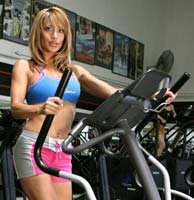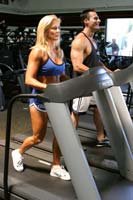
TOPIC: What Is The Best High Intensity Cardio Workout?

The Question:
Sure you can burn a little fat with cardio, but with high intensity cardio you would be able to do so much more.
What is the best high intensity cardio workout? Be specific.
What are some of the benefits of a high intensity cardio workout?
What are some of the drawbacks of a high intensity cardio workout?
Who would benefit from a high intensity cardio workout over a low intensity cardio workout?
Show off your knowledge to the world!
The Winners:
- LaxPro View Profile
- Prizes:
- 1st place - 75 in store credit.
2nd place - 50 in store credit.

1st Place - LaxPro
View This Author's BodySpace Here.

It is no question that cardiovascular activity promotes great health benefits such as fat loss and endurance capacity. The debate rages on (and probably will forever) as to what the best cardio method may be.
Although there is no one correct answer, as different forms offer different benefits, one-aspect remains constant - doing cardio is better than not doing any cardio at all. Unfortunately, many view cardio as mundane and an annoyance. It takes some or all of their will and mental focus just to step onto a cardio machine, and more often than not, they consider their work to be done at the first break of a sweat.
I've come to the realization that cardio doesn't have to be boring. What separates cardio the most from weight training, which many deem to be enjoyable, is that cardio is often very drawn out and repetitive whereas weight training (per exercise) is brief and contains much variety to always keep you on your toes.
It is in my belief that if you can replicate cardiovascular exercise to resemble weight training as closely as possible, it will have more staying power, that is, people will be more inclined to do it and stay with it.

The Best Workout
Although the best high intensity cardio workout can be debated just as many other things, it is in my belief that two variables greatly add to and increase the value of a high intensity workout.
1. Cardio Machines:
The first is to utilize some sort of cardio machine.
The benefits of a machine, as opposed to running around a track for example, are that you can set your pace. This is a very valuable tool, because the work you do remains constant, there is no slacking off or slowing down, unless you consciously fail yourself by lowering the rate.
Another great asset in using a cardio machine, especially during high intensity training, is that you can clearly monitor your pace, speed, time, et cetera. For instance, you can look at the machine timer and sprint for a minute, and then cool down for a few minutes.
One of the key points to high intensity training is that it must remain constantly taxing. With machines, there is no cheating. For instance, on your tenth sprint as opposed to your first you could be running slower and not even realize it as you are fatigued.
If you have the sprint pace at a constant level though, there is no slowing down. Finally, I enjoy machines because it is easier to "get in the zone" if you will.
It is much easier to space out and not think about the task at hand when you are running against a moving track in one direction as opposed to having to be constantly on the lookout for cars that may be coming or potholes that could potentially lead to an injury if you were to step in one! There are no real world factors to account for when utilizing machines.
2. Methods:
As I'm sure you can tell by now, I'm partial to machines for high intensity workouts. But which machines? TREADMILLS. These are hands down the best machine you can do for cardiovascular exercise. I've tested them all, from the elliptical, to the stair masters, to even the rowing machines. Nothing comes close to a treadmill.
Running is just so natural and you can't rely on momentum to carry you along like on some other machines. In my years in cardio rooms, I ironically, notice that treadmills are used the least. Why? Because they are the hardest!
Even when people do use a treadmill, the majority of the time they are walking on it, and we all know this is far from high intensity cardio. I also really like the treadmill because you seem to have a really great range of motion. You have to propel your bodyweight by taking large and rapid strides unless you want to fall off.
Running just seems to fit the body's natural way to move better. You aren't gliding along on an elliptical or taking little steps on a stair master, you are running, it is a full body exercise from your legs to the momentum that your arms create.

Routine
Now that I've established the tools and methods to a great high intensity routine, it is time to get down to the actual ROUTINE! The one thing that I notice that is hardly taken advantage of by many is the incline feature on the treadmill. Not only does this make your run harder, but it enables you to increase the intensity without necessarily having to run faster.
Another great advantage of using an incline in your run is that you stress different muscle groups in the legs. One of the main advantages of a stair master for example, is that it stresses your quads and glutes while you work on it.
By simply adding a significant incline to your run, you can mimic the benefits of a stair master quite well. In saying this, it is no surprise that my high intensity cardio routine will include an incline to really get you working.
The one thing about high intensity cardio is that it is extremely taxing. Taking this into account, it is necessary to have rest/recovery periods within your workout so you can maximize work expenditure when you need it the most - during your sprints.
Another problem/aspect that I often see is people taking it a little too easily on the recovery periods. People, this isn't time to be walking like you are an 80-year-old grandmother with a walking stick. A fast walk is sufficient to get you rested.
The key is to really focus on your breathing during both rest and sprint periods. You need to maximize the amount of oxygen you take in, to do this, it is essential to breath through the diaphragm.
Panting like a dog when you are tired won't work and won't give you the oxygen you need. You need to inhale deeply through your nose, and exhale through your mouth. You know you are breathing correctly when your chest rises as you inhale, as opposed to your stomach.
 Guidelines:
Guidelines:
- Start SLOW, It is important you get your form and technique down before anything else, you don't want to fall off the treadmill or risk injuring something.
- The fact that you will be using an incline and cooling down at a moderate to moderately quick walking pace further encourages the fact that you don't need full blown sprints. In fact, I don't remember the last time I ever sprinted with all my effort on a treadmill.
If you want staying power and if you want to continue to step on the treadmill for these sessions day in and day out, you can't afford to tire yourself out and tax your central nervous system.
- Your incline doesn't have to be TOO high. You want it just high enough where it feels like you are actually walking/running up a slight hill. I've noticed that when I put the incline at it's first or second least setting, I can't really tell anything at all has happened. Don't be lazy, but don't make it feel like you are sprinting up Mount Everest either.
- I recommend starting with fifteen minutes of running/walking and topping off at twenty-five when you are able. The key is to focus on progression; you need to constantly progress in at least one area. Try and make one aspect, the incline, duration, cool down, or fast run greater each session.
- Keep your cool down/intense periods at a 2:1 ratio. Personally, I like to run my butt off for a minute and then fast walk for two. I highly doubt you would be able to fully sprint for a minute, which is another reason why I like the fast, hard run better.
- It is also important to note, that everything is all relative. A moderate to fast walk on the cool down and an intense run on during the intense period may not seem to be that hard to someone else. The same goes for the incline. Go at a rate at which you feel you are working to meet the needs and requirements of the program. Don't cheat yourself!
I feel wary about outlining an exact routine as every person is at different skill levels and physical capacities. Also, I feel an exact routine isn't the most important factor; progression is.
Just like with weights, progression and overload is key. You need to progress in either, speed, time, or degree of incline to constantly improve cardiovascular activity or keep fat loss going. However, to not leave you all completely in the dark, here are a few guidelines.

Benefits
High intensity training encompasses quite a few benefits over its lower intensity higher duration version. The most attractive appeal of it for most is that you have to spend a fraction of the time compared to if you were to run at a slower rate.
In the world today, where people are constantly strapped for time due to either work, family, or other such obligations, it is great to know you can get just as good of a cardio workout in about half the time. Another great benefit is that you will, I can almost guarantee, find it more entertaining and it will go by much quicker.
Your cool down periods will feel like they whiz by as you recover from your hard run, and when you are running, your adrenaline is pumping knowing you have to get through the sprint!
As far as physiologically, high intensity type cardio variations, although burning less calories during the actual session itself, raises your basal metabolic rate and the rate at which your body burns calories throughout the rest of the day! Whereas the fat burning process pretty much comes to a halt during lower intensity variations, you are a human calorie-burning furnace for an entire day with this high intensity component.

Drawbacks
Drawbacks are few with high intensity cardio but they still exist. Although most view long duration as incredibly boring, most see this version as extremely difficult. High intensity cardio requires a certain mindset and attitude.
You need to be prepared to wage war with the treadmill each and every time you step on it. You need to be ready and say to yourself, "I'm going to complete this session!" if you are not prepared for it mentally and physically, high intensity cardio regimes may not be for you.
Another drawback to high intensity cardio is that many view it as a problem regarding muscle loss. When you force your body to work at such an extreme rate, it's going to look for any energy source available, including muscle, to keep it going.
This is why I think it is very important to do this cardio activity with something in your stomach. The key is trying to figure out what it is you should eat.
The meal shouldn't contain too many calories, because you want to be burning fat during your exercise, it should also be low in carbohydrates, as we all know these are burned first before any fat in exercise. I recommend a scoop of protein with a skim milk/water combination. If you can afford it, amino acids will greatly aid in your pre-cardio cocktail.

Not For Everyone
It is important that I add in this disclaimer before I end my post. High intensity cardio is not for everyone! Those who are overweight could be at a serious health risk if they try and perform an intense activity such as this.
Any cardio will do for those who are overweight - you don't need to be taxing your heart with extreme cardio when it hasn't been used to much activity at all. On the flip side, these cardio type programs are beneficial for many.
Perhaps you have been doing slower, longer duration cardio for quite a while and need a change, this could be perfect for you. Just as how you need to change your weight lifting program from time to time, cardio variety is important to keep things fresh and improving.
Also, if you are strapped for time, this is also the perfect workout. You can get great benefits from high intensity cardio and it doesn't involve you being on a treadmill for an hour (just fifteen or so minutes, lol). Finally, and of course, elite athletes looking to bolster their forty-yard dash or endurance capacity would also find this type of program a great asset.

Cardio Can Be Fun
Now, for the first time, cardio can actually be fun (okay, somewhat!) and still equally effective. High intensity cardio regimes are somewhat of a recent phenomenon and really have only gained public spotlight recently.
Many people rave about them and for good reason, they seem to have just as many positives as longer duration cardio but you don't have to spend forever doing it. It is always important to remember, however, that consistency, and progression, which is achieved and capable by the former, is key.
If you do not have these two aspects of your training down, no matter how effective a program, you will not achieve the results you are searching for.
-GW
LaxPro






